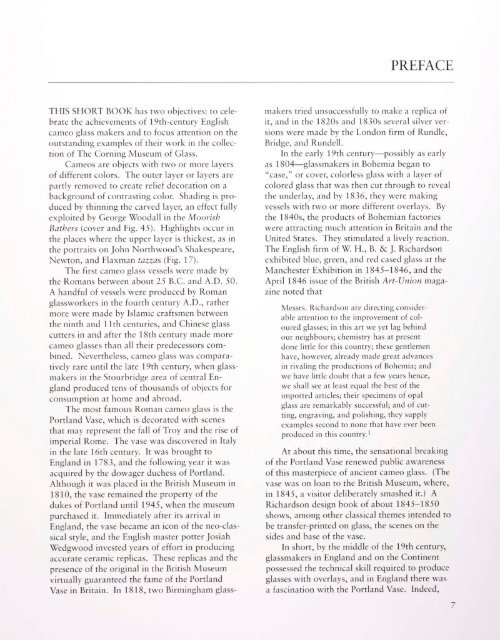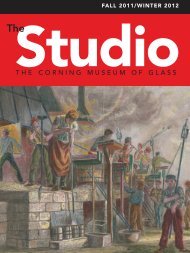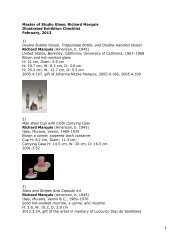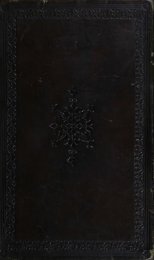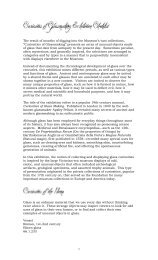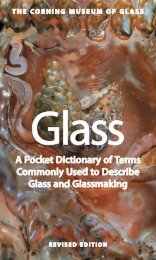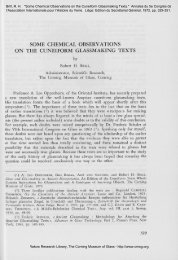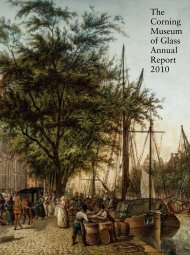english cameo glass in the corning museum of glass
english cameo glass in the corning museum of glass
english cameo glass in the corning museum of glass
Create successful ePaper yourself
Turn your PDF publications into a flip-book with our unique Google optimized e-Paper software.
THIS SHORT BOOK has two objectives: to celebrate<br />
<strong>the</strong> achievements <strong>of</strong> 19th-century English<br />
<strong>cameo</strong> <strong>glass</strong> makers and to focus attention on <strong>the</strong><br />
outstand<strong>in</strong>g examples <strong>of</strong> <strong>the</strong>ir work <strong>in</strong> <strong>the</strong> collection<br />
<strong>of</strong> The Corn<strong>in</strong>g Museum <strong>of</strong> Glass.<br />
Cameos are objects with two or more layers<br />
<strong>of</strong> different colors. The outer layer or layers are<br />
partly removed to create relief decoration on a<br />
background <strong>of</strong> contrast<strong>in</strong>g color. Shad<strong>in</strong>g is produced<br />
by th<strong>in</strong>n<strong>in</strong>g <strong>the</strong> carved layer, an effect fully<br />
exploited by George Woodall <strong>in</strong> <strong>the</strong> Moorish<br />
Ba<strong>the</strong>rs (cover and Fig. 45). Highlights occur <strong>in</strong><br />
<strong>the</strong> places where <strong>the</strong> upper layer is thickest, as <strong>in</strong><br />
<strong>the</strong> portraits on John Northwood's Shakespeare,<br />
Newton, and Flaxman tazzas (Fig. 17).<br />
The first <strong>cameo</strong> <strong>glass</strong> vessels were made by<br />
<strong>the</strong> Romans between about 25 B.C. and A.D. 50.<br />
A handful <strong>of</strong> vessels were produced by Roman<br />
<strong>glass</strong>workers <strong>in</strong> <strong>the</strong> fourth century A.D., ra<strong>the</strong>r<br />
more were made by Islamic craftsmen between<br />
<strong>the</strong> n<strong>in</strong>th and 11th centuries, and Ch<strong>in</strong>ese <strong>glass</strong><br />
cutters <strong>in</strong> and after <strong>the</strong> 18th century made more<br />
<strong>cameo</strong> <strong>glass</strong>es than all <strong>the</strong>ir predecessors comb<strong>in</strong>ed.<br />
Never<strong>the</strong>less, <strong>cameo</strong> <strong>glass</strong> was comparatively<br />
rare until <strong>the</strong> late 19th century, when <strong>glass</strong>makers<br />
<strong>in</strong> <strong>the</strong> Stourbridge area <strong>of</strong> central England<br />
produced tens <strong>of</strong> thousands <strong>of</strong> objects for<br />
consumption at home and abroad.<br />
The most famous Roman <strong>cameo</strong> <strong>glass</strong> is <strong>the</strong><br />
Portland Vase, which is decorated with scenes<br />
that may represent <strong>the</strong> fall <strong>of</strong> Troy and <strong>the</strong> rise <strong>of</strong><br />
imperial Rome. The vase was discovered <strong>in</strong> Italy<br />
<strong>in</strong> <strong>the</strong> late 16th century. It was brought to<br />
England <strong>in</strong> 1783, and <strong>the</strong> follow<strong>in</strong>g year it was<br />
acquired by <strong>the</strong> dowager duchess <strong>of</strong> Portland.<br />
Although it was placed <strong>in</strong> <strong>the</strong> British Museum <strong>in</strong><br />
1810, <strong>the</strong> vase rema<strong>in</strong>ed <strong>the</strong> property <strong>of</strong> <strong>the</strong><br />
dukes <strong>of</strong> Portland until 1945, when <strong>the</strong> <strong>museum</strong><br />
purchased it. Immediately after its arrival <strong>in</strong><br />
England, <strong>the</strong> vase became an icon <strong>of</strong> <strong>the</strong> neo-classical<br />
style, and <strong>the</strong> English master potter Josiah<br />
Wedgwood <strong>in</strong>vested years <strong>of</strong> effort <strong>in</strong> produc<strong>in</strong>g<br />
accurate ceramic replicas. These replicas and <strong>the</strong><br />
presence <strong>of</strong> <strong>the</strong> orig<strong>in</strong>al <strong>in</strong> <strong>the</strong> British Museum<br />
virtually guaranteed <strong>the</strong> fame <strong>of</strong> <strong>the</strong> Portland<br />
Vase <strong>in</strong> Brita<strong>in</strong>. In 1818, two Birm<strong>in</strong>gham <strong>glass</strong>-<br />
PREFACE<br />
makers tried unsuccessfully to make a replica <strong>of</strong><br />
it, and <strong>in</strong> <strong>the</strong> 1820s and 1830s several silver versions<br />
were made by <strong>the</strong> London firm <strong>of</strong> Rundle,<br />
Bridge, and Rundell.<br />
In <strong>the</strong> early 19th century—possibly as early<br />
as 1804—<strong>glass</strong>makers <strong>in</strong> Bohemia began to<br />
"case," or cover, colorless <strong>glass</strong> with a layer <strong>of</strong><br />
colored <strong>glass</strong> that was <strong>the</strong>n cut through to reveal<br />
<strong>the</strong> underlay, and by 1836, <strong>the</strong>y were mak<strong>in</strong>g<br />
vessels with two or more different overlays. By<br />
<strong>the</strong> 1840s, <strong>the</strong> products <strong>of</strong> Bohemian factories<br />
were attract<strong>in</strong>g much attention <strong>in</strong> Brita<strong>in</strong> and <strong>the</strong><br />
United States. They stimulated a lively reaction.<br />
The English firm <strong>of</strong> W. H., B. 8c J. Richardson<br />
exhibited blue, green, and red cased <strong>glass</strong> at <strong>the</strong><br />
Manchester Exhibition <strong>in</strong> 1845-1846, and <strong>the</strong><br />
April 1846 issue <strong>of</strong> <strong>the</strong> British Art-Union magaz<strong>in</strong>e<br />
noted that<br />
Messrs. Richardson are direct<strong>in</strong>g considerable<br />
attention to <strong>the</strong> improvement <strong>of</strong> coloured<br />
<strong>glass</strong>es; <strong>in</strong> this art we yet lag beh<strong>in</strong>d<br />
our neighbours; chemistry has at present<br />
done little for this country; <strong>the</strong>se gentlemen<br />
have, however, already made great advances<br />
<strong>in</strong> rival<strong>in</strong>g <strong>the</strong> productions <strong>of</strong> Bohemia; and<br />
we have little doubt that a few years hence,<br />
we shall see at least equal <strong>the</strong> best <strong>of</strong> <strong>the</strong><br />
imported articles; <strong>the</strong>ir specimens <strong>of</strong> opal<br />
<strong>glass</strong> are remarkably successful; and <strong>of</strong> cutt<strong>in</strong>g,<br />
engrav<strong>in</strong>g, and polish<strong>in</strong>g, <strong>the</strong>y supply<br />
examples second to none that have ever been<br />
produced <strong>in</strong> this country. 1<br />
At about this time, <strong>the</strong> sensational break<strong>in</strong>g<br />
<strong>of</strong> <strong>the</strong> Portland Vase renewed public awareness<br />
<strong>of</strong> this masterpiece <strong>of</strong> ancient <strong>cameo</strong> <strong>glass</strong>. (The<br />
vase was on loan to <strong>the</strong> British Museum, where,<br />
<strong>in</strong> 1845, a visitor deliberately smashed it.) A<br />
Richardson design book <strong>of</strong> about 1845-1850<br />
shows, among o<strong>the</strong>r classical <strong>the</strong>mes <strong>in</strong>tended to<br />
be transfer-pr<strong>in</strong>ted on <strong>glass</strong>, <strong>the</strong> scenes on <strong>the</strong><br />
sides and base <strong>of</strong> <strong>the</strong> vase.<br />
In short, by <strong>the</strong> middle <strong>of</strong> <strong>the</strong> 19th century,<br />
<strong>glass</strong>makers <strong>in</strong> England and on <strong>the</strong> Cont<strong>in</strong>ent<br />
possessed <strong>the</strong> technical skill required to produce<br />
<strong>glass</strong>es with overlays, and <strong>in</strong> England <strong>the</strong>re was<br />
a fasc<strong>in</strong>ation with <strong>the</strong> Portland Vase. Indeed,


